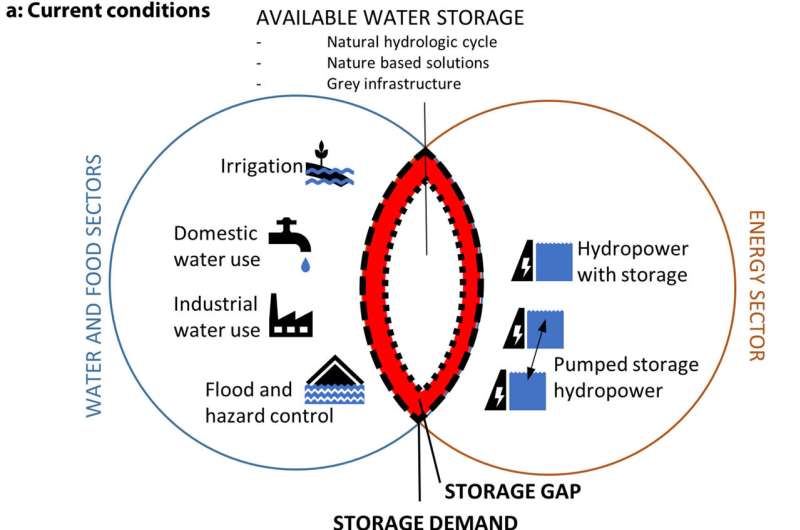This article has been reviewed according to Science X's editorial process and policies. Editors have highlighted the following attributes while ensuring the content's credibility:
fact-checked
trusted source
proofread
'Gray infrastructure' can't meet future water storage needs, study finds

A new study maps how energy and food systems depend on stored water to generate hydropower and feed irrigation. Dams and reservoirs won't be able to meet the demand in coming decades.
As demand for food and energy grows, water will only become more precious. A new Stanford-led study provides a first-of-its-kind global overview of the role dams and reservoirs play in providing water storage, revealing so-called gray infrastructure won't be enough to meet future demands for hydropower and agricultural irrigation.
The analysis, published in Renewable and Sustainable Energy Reviews, underscores the necessity of exploring demand- and supply-side alternatives, such as other renewable energy sources and nature-based approaches for water storage.
"Water storage is a critical and globally limited resource," said study lead author Rafael Schmitt, a lead scientist at the Stanford-based Natural Capital Project. "Our study shows that the solutions of the past are insufficient, and can be damaging to already overstretched freshwater ecosystems."
Making better infrastructure decisions
Dams and reservoirs fuel hydropower, store water for irrigation, provide drinking water, and lower flood risks. They also inflict ecological and societal damage by disrupting fish migrations and displacing people and terrestrial ecosystems, among other impacts.
To help policymakers make more informed decisions about gray infrastructure and alternatives, Schmitt and co-author Lorenzo Rosa, a principal investigator at Carnegie Science and an assistant professor (by courtesy) of Earth system science in the Stanford Doerr School of Sustainability, trained their focus on crucial gaps in our understanding of how dams and reservoirs contribute to food and energy security.
"Our study by no means advocates for building more dams. What we urgently need is a global debate about how to meet water storage needs for critical sectors," says Rafael Schmitt, lead scientist, Stanford Natural Capital Project.
The researchers used machine learning to quantify the multipurpose roles of the world's 6,000 largest dams and reservoirs. The analysis revealed that dammed reservoirs globally store about 1,000 times the volume of California's largest man-made lake, Shasta Lake. Of that, less than 5% reaches irrigated crops.
The dams analyzed provide 505 gigawatts of hydropower, 40% of current total global hydropower capacity, according to the study. Worldwide, about 3,700 dams have been identified for potential development. If all of them were constructed, they could provide about 60% more energy and about 40% more stored water for irrigation, according to the study.
The study forecasts the global need for stored irrigation water will grow by about 70%—enough to cover an area the size of California under nearly two feet of water.
Despite this potential, the analysis shows that deficits persist in some countries and regions. The projections highlight that even with the construction of several thousand new dams, there won't be nearly enough hydropower and stored irrigation water to meet energy and irrigation needs in India, central Europe, and several Asia-Pacific nations.
Those needs will be considerable: The study projects global demand for hydropower will grow approximately 35% between now and 2050, while the global need for stored irrigation water will grow by about 70%—enough to cover an area the size of California under nearly two feet of water.
As demands for irrigation and hydropower grow, gaps between sectoral needs and what dams can provide will widen. As both hydropower and irrigation often rely on the same dammed reservoirs, the risk for conflicts between these sectors increases as well.
"Our study by no means advocates for building more dams," said Schmitt. "What we urgently need is a global debate about how to meet water storage needs for critical sectors."
Exploring alternatives
Addressing these needs sustainably will require taking pressure off gray infrastructure through policies that promote renewable energy technologies; nature-based solutions such as increasing soil water retention; and alternative water storage solutions such as small storage ponds, managed aquifer recharge, and improved agricultural water management, according to the study's authors.
Where hydropower lags behind demand, other renewable energy sources could pick up the power slack and even allow dam operations to shift focus toward irrigation. Conversely, increasing reliance on non-gray infrastructure storage options could make it easier for dam operations to shift toward producing more energy, making it possible to build fewer and smaller hydropower projects.
Where both hydropower and stored irrigation water are in short supply, the need for alternatives to dams and reservoirs will be all the more acute, according to the researchers.
"Because 40% of the world's food production depends on irrigation, understanding the dual role of water storage for irrigation and energy is paramount," said Rosa, who is also a principal investigator at the Carnegie Institution for Science's Department of Global Ecology.
"This study illuminates the path forward for sustainable development, emphasizing the critical synergy between water infrastructure, climate adaptation, and agricultural resilience."
More information: Rafael Jan Pablo Schmitt et al, Dams for hydropower and irrigation: Trends, challenges, and alternatives, Renewable and Sustainable Energy Reviews (2024). DOI: 10.1016/j.rser.2024.114439


















